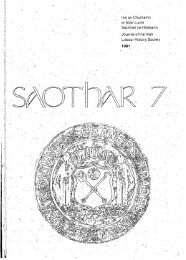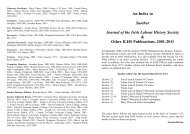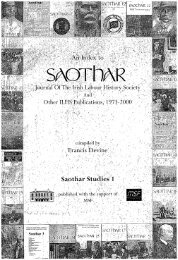24 SAOTHAR 13normal times they went to England to earn the rent for their holdings, but they were unable to do so in1879 as they could not secure credit from the local shopkeepers for their fares.?By the 1860s and 1870s migrants increasingly used the post-office to send remittancesto relativesat home. This contrasted with the previous practice of bringing the savings back personally at the endof their stay in Britain; an unsafe practice, as they had often become the targets of thieves and other suchrogues. But even the post-office system was not without its problems. High levels of illiteracy amongstthe migran~ made the collection and transmission of remittances difficult. That the migrants were ableto overcome this handicap illustrates the community spirit that existed amongst them. Illiteratemigrants came to depend greatly on local people or the minority of their fellows who could read. Inthe west ofIreland a major burden was placed on shopkeepers and postmasters to ensure that the correctperson received the money. Problems of identity ensued because frequently the illiterate recipient gota neighbour to sign the form and at times this resulted in litigation in pursuit of stolen money.sOnly with the aid of official returns, which came into being in 1880, is it possible to examine thegeographical spread of seasonal migration. Prior to this the only means of evaluating the overall extentof seasonal migration on a local basis is through the evidence supplied at the Bessborough Commissionin 1880. It is fortunate that returns were recorded from 1880, as this was the high point of seasonalmigration in the post-famine period and provides us with a norm from which to work with up to the1920s. The only other returns availabe were provided in 1841 and provide us with an insight into thepte-famine situation. What is apparent from the 1880 data is the concentration of migrants in what canbe regarded as the most remote and certainly the most agriculturally underdeveloped regions of thecountry, comprising such counties as Mayo, Donegal, Roscommon and Galway. It illustrates theinterrelationships between migration, poverty, and under-employment in these regions. Despite itsrecurrent division of communities, seasonal migration, because of the income it produced, was also anincreasingly relevant factor in the preservation of communities in remote regions until well into thetwentieth century. There was less incentive to emigrate permanently too due to other factors. A highproportion (over fifty per cent) of the migrants were Irish speakers. They found companionship intravelling with friends and relations who spoke the same language and came from their own townlands.Seasonal migration was iri effect the transference of whole communities from Ireland to Britain,communities which were prone as a group to return to their home place at the end of the season. Thosemigrants who did settle permanently in Britain tended to be individuals who had no ties to land in Irelandand who had travelled alone to their seasonal job.County Mayo appears to have held the highest concentration of seasonal migrants, accounting forforty percent of the total in 1880. Between 1841 and1880 the numbers remained static, but in relativeterms, owing to a significant decrease in the post-famine population, this meant a growing dependence.In 1841, thirty one per thousand of the county's population were dependent on the seasonal migrationremittances from Britain as a principal source of incorpe for rent. By 1880, of the 27 ,659 migrants whohad left Ireland, 10, 198 (or 41. 7 perthousand ofthe county) were from Mayo.9 Between 1880 and 1897,Mayo's dependency on seasonal migration remained high and was much greater than for the other threecounties with high levels of migration. The numbers per thousand from Mayo were up to four timeshigher.Within Mayo, Roscommon and Donegal major regional variations existed, with poor law unionssuch as Swinford, Claremorris, Castlereagh and Dunfanaghy being major suppliers of migrants. Theone common characteristic in all these regions was widespread poverty and the uneconomic size of theirholdings. Other unions remained untouched by the annual haemorrhage. With the exception of Achilland west Donegal, which had direct links with Scotland through the nearby ports ofW estport and Derry,seasonal migration was, up to the 1890s, confined primarily to the interior regions of the westerncounties. A number of factors were responsible for the low level of migration from coastal regions.Poor transport and communications discouraged travel. The manufacture of kelp, access to fishing, andthe government assisted emigration schemes of the Tuke Committee to North America in the 1880s,all contributed to the small numbers of migrants from areas like Clifden, Erris and Belmullet. It was
A PASSAGE TO BRITAIN 25only in the 1890s, when the Congested Districts Board helped to open the region with a rail and roadnetwork, that the passage east made migration an option in the coastal areas. It is ironic that while thisbody improved acceSs to these remote regions with a view to establishing industries and developingtourism, the effect was to accelerate the number of migrants leaving. Also of note is the co-relationshipbetween regional subsistence crises and migration, such as occurred in Erris and Belmullet during thepotato failures of the 1890s. The failure of the potato had the inevitable effect of a dramatic increasein migration, being the only alternative to famine.Officially, most migrants were classified as landless agricultural labourers for statistical purposes.In 1880, sixty-three per cent were returned as having :no land. This classification is, however,misleading and fails to highlight the importance of the whole family in the process. Many of th~ landlessmigrants were the relati ves oflandowning farmers, as was the case with Achill and Inishowen migrants,and they were supplementing the family income in both the payment of rent and warding off famine.This analysis supports Charles Trevelyn' s view, when he stated in the House of Commons in 1883:' ... the proportion of migratory agricultural labourers from a district is the proof of the poverty of thedistrict, and the inability of the holdings ... to support the people.' 10The most noticeable feature of the composition of migration from the west of Ireland was the.proportion of landowners who held under thirty acres, a further testimony to the unviable structure ofholdings in the region. These accounted for about forty per cent of Mayo migrants and thirty per centfrom the three other counties. In the 1880s a twenty acre holding was needed to support the averagefamily, with much larger holdings needed in western regions. It would have been difficult, if notimpossible, for tenant farmers in Swinford, Newport and Castlebar to exist on the average holding, apoint demonstrated by the number of farmers, as well as landless labourers, who were dependent onmigrant remittances. While a farmer was regarded as a person who was totally dependent on theproduce of his holding for a livelihood, it is clear that not many west ofIreland farmers accorded withthis classification. As the rent was paid from earnings from external seasonal migration, rentreductions, whether accorded judicially or voluntarily, meant little to these tenants, as demonstrated onthe Taaffe Estate in Mayo and Gal way. The poverty of the land rendered it impossible to remain totallydependent on its produce.The social impact of seasonal migration could be severe in the poorer districts. In 1880, migrantsacounted for 91.6 per thousand of the population in Swinford Poor Law Union, whilst the figure inClaremorris was 57 and in Dunfanaghy 51.4 per thousand. It is generally accepted that the estimate ofmigrants is conservative. 6 Grada has suggested that official figures accounted for only sixty per centof the totalY As the Registrar-General 's returns relied exclusively on data from the railway companies,and in particular on details of those availing of the special fourth class passage, and were compiled ata time when all migrants had not departed, they fail to consider the large numbers who made alternativearrangements. There are cases where the Registrar-General's returns are totally inaccurate, and nonemore so than in the case of the Newport Union. Migrant numbers from the whole of Ireland reachedpeak levels in 1881 for the period of the returns. Yet only 554 migrants are recorded as having leftNewport and of these only five went to Scotland. According to contemporary writers like MichaelDavitt, and witnesses to the Bessborough Commission, close to one thousand migrants actuallydeparted from Achill to Scotland. Consequently it would appear that even 6 Grada's estimates are toolow.Seasonal migration was crucial in the survival of many communities throughout the region. Using6 Grada's adjustment factor of sixty percent, migrants from Swinford would have numbered 152.6 perthousand of the population, 95 for Claremorris and 86.1 for Dunfanaghy in 1881. When spouses anddependents are taken into consideration the extent to which seasonal migration contributed to theupkeep of whole communities becomes clear. Up to three-quarters of S winford' s population dependedheavily on these remittances, whilst the figures lie close to one-half in the other two unions. This doesnot allow for those who benefited indirectly from the wages of seasonal migrants, such as landlords,
- Page 1 and 2: JOURNAL OF THE IRISH LABOUR HISTORY
- Page 3 and 4: ContentsPageEditorial: Labour Histo
- Page 5 and 6: EDITORIAL 3freedom to participate i
- Page 7 and 8: CorrespondenceThe Irish Labour Part
- Page 9 and 10: ; ~ ; ,The Decline and Fall of Donn
- Page 11 and 12: THE DECLINE AND FALL OF DONNYBROOK
- Page 13 and 14: THE DECLINE AND FALL OF DONNYBROOK
- Page 15 and 16: ·' THE DECLINE AND FALL OF DONNYBR
- Page 17 and 18: THE DECLINE AND FALL OF DONNYBROOK
- Page 19 and 20: THE DECLINE AND FALL OF DONNYBROOK
- Page 21 and 22: THE DECLINE AND FALL OF DONNYBROOK
- Page 23 and 24: THE DECLINE AND FALL OF DONNYBROOK
- Page 25: ,'-,;-''''.A PASSAGE TO BRITAIN 23C
- Page 29 and 30: A PASSAGE TO BRITAIN 27clothing._De
- Page 31 and 32: A PASSAGE TO BRITAIN 29established
- Page 33 and 34: ;:-.",.- .. .", ...... '.:. '
- Page 35 and 36: LOUIE BENNETI 33feminist movement w
- Page 37 and 38: :... ~: ."
- Page 39 and 40: -.- '.LOUlE BENNETT 37While there i
- Page 41 and 42: LOUIE ~ENNEIT 39Xl's encyclical Qua
- Page 43 and 44: LOUIE BENNEIT 41Bennett's own relat
- Page 45 and 46: LODIE BENNETT 43109; IWWU resolutio
- Page 47 and 48: Essays in ReviewCosherers, Wanderer
- Page 49 and 50: ••• .".'. >. '~"ESSA YS IN RE
- Page 51 and 52: ESSAYS IN REVIEW 49ConnolIy:Myth an
- Page 53 and 54: ESSAYS IN ~EVIEW 51tion' in the Int
- Page 55 and 56: ESSAYS IN REVIEW53International:'I
- Page 57 and 58: REVIEWScontroversy is real history.
- Page 59 and 60: REVIEWSJoe Monks was among the earl
- Page 61 and 62: REVIEWSnolly-Column Song','Proudly
- Page 63 and 64: REVIEWSresulting from the arrival o
- Page 65 and 66: REVIEWS,63the book by means of an a
- Page 67 and 68: REVIEWSlogue, it is hardly surprisi
- Page 69 and 70: The Team For All Workers ...CULIAIB
- Page 71 and 72: ESSAYS 69mission and moral refonn.l
- Page 73 and 74: .. ...... ~.~ -~ .'- '.ESSAYS. 71fr
- Page 75 and 76: ESSAYS 73claimed authority but whic
- Page 77 and 78:
ESSAYS 75provided the basis for soc
- Page 79 and 80:
ESSAYS 779. For comparisons see E.T
- Page 81 and 82:
ESSAYS 7952. Annals of Christ Churc
- Page 83 and 84:
ESSAYS' 81Fianna Fail and the Worki
- Page 85 and 86:
ESSAYS 83Eireann in 1925 visibly di
- Page 87 and 88:
ESSAYS 85recognition of the impract
- Page 89 and 90:
ESSAYS 871970, it created the condi
- Page 91 and 92:
ESSAYS89The Irish Immigrants' Contr
- Page 93 and 94:
ESSAYS" 91Although anti -Catholic p
- Page 95 and 96:
ESSAYS 93McCowie played a key role
- Page 97 and 98:
:. -,,'.' ',. .~.,:.ESSAYS 95Althou
- Page 99 and 100:
ESSAYS 97young girl of their own ba
- Page 101 and 102:
SourcesIrish Labour History Society
- Page 103 and 104:
SOURCES 101INovember, 1971 to no. 1
- Page 105 and 106:
SOURCES 103would claim credit for t
- Page 107 and 108:
SOURCES105Sources for Irish Labour
- Page 109 and 110:
SOURCES 107NorthWest Archives and L
- Page 111 and 112:
SOURCES 109In 1966 the Finnish gove
- Page 113 and 114:
TURNINGANEWLEAFThe CPSSUis the larg
- Page 115 and 116:
REMINISCENCE 113us due to my politi
- Page 117 and 118:
REMINISCENCE 115when Jim was presen
- Page 119 and 120:
REMINISCENCE 117of Dail Eireann. 17
- Page 121 and 122:
REMINISCENCE 119NotesThe above arti
- Page 123 and 124:
DOCUMENT STUDY 121James Connolly in
- Page 125 and 126:
DOCUMENT STUDY123SOCIAL DEMOCRATIC
- Page 127 and 128:
DOCUMENT STUDY 125proletariat of th
- Page 129 and 130:
DOCUMENT STUDY 127the support of Je
- Page 131 and 132:
DOCUMENT STUDY 12926. The Workers'
- Page 133 and 134:
131BibliographyA Bibliography of Ir
- Page 135 and 136:
BIBLIOGRAPHY 133Compton, P.A. Demog
- Page 137 and 138:
BIBLIOGRAPHY 135Levine, I. and Madd
- Page 139 and 140:
BIBLIOGRAPHY 137Turner, M. 'Towards
- Page 141 and 142:
BIBLIOGRAPHY 1394. Land and Agricul
- Page 143 and 144:
BIBLIOGRAPHY 141Clogher Record12 (2
- Page 145 and 146:
BIBLIOGRAPHY 143Political Research
- Page 147 and 148:
BIBLIOGRAPHY 145Pres, 1987.O'Brien,
- Page 149 and 150:
147Notes on Contributorsf onathanBe
- Page 151 and 152:
1901: Ireland's first general union
- Page 153 and 154:
ELECTRICAL TRADES UNION .Establishe





